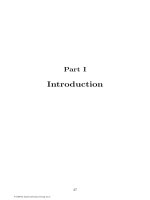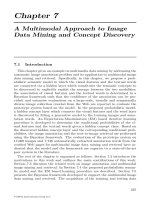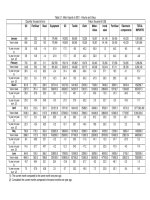Tài liệu VOLCANOES pptx
Bạn đang xem bản rút gọn của tài liệu. Xem và tải ngay bản đầy đủ của tài liệu tại đây (1.08 MB, 13 trang )
VOLCANOES!
Volcanic eruptions are among the Earth's most powerful and destructive forces. Imagine
hearing a volcano erupt thousands of miles away. Imagine looking through binoculars
and seeing the top of a mountain collapse. Imagine discovering an ancient Roman city
that had been buried in volcanic ash.
Volcanoes are also creative forces. The Earth's first oceans and atmosphere formed from
the gases given off by volcanoes. In turn, oceans and an atmosphere created the
environment that made life possible on our planet. Volcanoes have also shaped the
Earth's landscape. Many of our mountains, islands, and plains have been built by volcanic
eruptions.(Description of Figure 1.)
Why Do Volcanoes Erupt?
Deep within the Earth it is so hot that some rocks slowly melt and become a thick
flowing substance called magma. Because it is lighter than the solid rock around it,
magma rises and collects in magma chambers. Eventually some of the magma pushes
through vents and fissures in the Earth's surface. A volcanic eruption occurs! Magma
that has erupted is called lava.
Some volcanic eruptions are explosive and others are not. How explosive an eruption is
depends on how runny or sticky the magma is. If magma is thin and runny, gases can
escape easily from it. When this type of magma erupts, it flows out of the volcano. Lava
flows rarely kill people, because they move slowly enough for people to get out of their
way. Lava flows, however, can cause considerable destruction to buildings in their path.
If magma is thick and sticky, gases cannot escape easily. Pressure builds up until the
gases escape violently and explode. In this type of eruption, the magma blasts into the air
and breaks apart into pieces called tephra. Tephra can range in size from tiny particles of
ash to house-size boulders.
Explosive volcanic eruptions can be dangerous and deadly. They can blast out clouds of
hot tephra from the side or top of a volcano. These fiery clouds race down mountainsides
destroying almost everything in their path. Ash erupted into the sky falls back to Earth
like powdery snow, but snow that won't melt. If thick enough, blankets of ash can
suffocate plants, animals, and humans. When hot volcanic materials mix with water from
streams or melted snow and ice, mudflows form. Mudflows have buried entire
communities located near erupting volcanoes.
Because there may be hundreds or thousands of years between volcanic eruptions, people
may not be aware of a volcano's dangers. When Mount St. Helens in the State of
Washington erupted in 1980, it had not erupted for 123 years. Most people thought
Mount St. Helens was a beautiful, peaceful mountain and not a dangerous volcano.
Where Do Volcanoes Erupt?
(Description of Figure 2.)
Volcanoes occur because the Earth's crust is broken into plates that resemble a jigsaw
puzzle. There are 16 major plates. These rigid plates float on a softer layer of rock in the
Earth's mantle. As the plates move about they push together or pull apart. Most
volcanoes occur near the edges of plates.
When plates push together, one plate slides beneath the other. This is a subduction zone.
When the plunging plate gets deep enough inside the mantle, some of the rock on the
overlying plate melts and forms magma that can move upward and erupt at the Earth's
surface. At rift zones, plates are moving apart and magma comes to the surface and
erupts. Some volcanoes occur in the middle of plates at areas called hotspots - places
where magma melts through the plate and erupts.
Why Do Volcanoes Grow?
Volcanoes grow because of repeated eruptions. There are three main kinds, or shapes, of
volcanoes based on the type of materials they erupt.
(Description of Figure 3.)
Stratovolcanoes
build from
eruptions of lava
and tephra that
pile up in layers,
or strata, much
like layers of
cake and
frosting. These
volcanoes form
symmetrical
cones with steep
sides.
(Description of Figure 4.)
Cinder cones
build from
erupting lava
that breaks
into small
pieces as it
blasts into the
air. As the lava
pieces fall
back to the
ground, they
cool and
harden into
cinders that
pile up around
the volcano's
vent. Cinder
cones are very
small cone-
shaped
volcanoes.
(Description of Figure 5.)
Shield
volcanoes
form from
eruptions of
flowing lava.
The lava
spreads out
and builds up
volcanoes with
broad, gently
sloping sides.
The shape
resembles a
warrior's
shield.
|| Top || VOLCANOES! home ||
Mount St. Helens!
On May 18, 1980, Mount St. Helens violently erupted. For 2 months the volcano showed
signs that it was waking up from its 123-year sleep. Earthquakes beneath the mountain
increased. Steam and ash erupted. And a "bulge" grew on the mountain's steep north side.
All these warning signs signaled that magma was moving upward inside the volcano.
(Description of Figures 6-7.)
(Description of Figures 8-9.)
The First 35 Seconds
On the morning of the eruption, Gary Rosenquist was camped about 36 kilometers (11
miles) from the summit of Mount St. Helens. Another camper was looking through
binoculars and noticed that the upper right side of the volcano looked "fuzzy." He
shouted that the "mountain was going." Rosenquist began taking photographs.
An earthquake that occurred beneath the volcano shook loose the "bulge" on the
mountain's steep north side. Rock and ice slide down the mountain. Then the mountain
exploded gases, magma, and water laterally out the side where the "bulge" had been. The
explosion hurled hot rock and ash at hurricane speeds. Ash and steam erupted vertically
from the volcano's crater and continued for 9 hours.
The Mountain Blows its Top
Volcanic eruptions alter the surface of the Earth's lithosphere, the hard, outermost shell
of the Earth.
Many eruptions have built Mount St. Helens' beautiful cone shape. The May 18, 1980,
eruption, however, dramatically changed the volcano's size and shape. It tore off the
mountain's top and blasted a giant crater in its side.
Smaller eruptions have continued since 1980. Mostly occurring on the bottom of the
volcano's crater, each eruption squeezes up thick, pasty lava and sometimes spews out
tephra. In photograph number 11, look for the dome that has formed inside the crater.
Slowly, the volcano is rebuilding itself into its former shape.
Up in the Air
Volcanoes erupt
materials into the
atmosphere, the gases
and water vapor that
surround the Earth.
The eruption
blasted ash and
gases into the
atmosphere. Winds
carried ash great
distances. The ash-
covered truck
shown here was
parked 19
kilometers (12
miles) from Mount
St. Helens. Two
men who were
camped nearby
died, suffocating
from hot volcanic
ash. They were two
of 57 known
fatalities.
In Yakima, a city in
eastern Washington, ash
began to fall about an
hour after the eruption.
It became so dark that
lights were turned on all
day. Face masks were
necessary when people
went outside. It took 10
weeks to haul away the
ash from Yakima's
streets, sidewalks, and
roofs.
Water, Rock, and Mud
The hydrosphere — the liquid water on and under the Earth's surface — can make
volcanic eruptions more dangerous.
Before the May 18, 1980, eruption, the streams on Mount St. Helens were crystal clear.
After the eruption, streams were choked with rock and mud. When water mixed with rock
and mud, it created volcanic mudflows (also called lahars) that were able to move down
the volcano's slopes. On the steepest slopes, the mudflows traveled up to 144 kilometers
per hour (90 miles per hour). Some of the mudflows were as high as a six-storied
building!
Fire and Ice
Ice and snow — the part of the Earth system called the cryosphere — can melt during a
volcanic eruption.
Snow- and ice-capped volcanoes like Mount St. Helens are especially dangerous if they
erupt. Much of the water in Mount St. Helens' mudflows came from snow and ice melted
by the heat of the eruption. These mudflows were as thick as wet cement and able to
carry along almost anything that they picked up. Eyewitnesses reported seeing mudflows
carry everything from farm animals to a fully loaded logging truck. Fortunately, when the
mudlfow hit, no one was in the bus pictured here.
Death and Recovery
The Earth's biosphere — the realm of all living things — is affected during a volcanic
eruption.
The force
of the
eruption on
Mount St.
Helens
blew down
giant trees
like they
were
match
sticks.
Almost all
of the
animals
that lived
in these
forests
were killed
as well.
Birds were
particularl
y hard hit.
Some birds
survived
the
eruption
but died
later
because
the insects
and plants
they ate
had died.
Surprisingly, some
plants and animals did
survive. Plants sprouted
from roots that survived
even though the plants'
tops had been sheared
off. Animals such as
gophers and ants
survived in their
underground homes.
Within a few weeks of
the eruption deer, elk,
and other animals
moved in from nearby
areas to take advantage
of the new plants that
were sprouting.
|| Top || VOLCANOES! home ||
This teacher packet was originally published and printed in 1997. The online edition
contains full text from the original publication. Some images have been modified or
added to improve the scientific visualization of information. All poster text and images
are available under the Poster section. A paper copy of the poster is for sale by calling 1-
888-ASK-USGS. The Master Sheets and some Activity Sheets are in PDF format. The
PDF format reproduces the printed publication and will be better for creating overlay
and overhead transparencies. To view and print PDF's install the Acrobat® Reader,
available at no charge from Adobe Systems. This document has undergone official
review and approval for publications established by the National Mapping Division, U.S.
Geological Survey.
Geography Water Biology Geology U.S. Geological Survey Dept. of Interior
U.S. Department of the Interior — U.S. Geological Survey — 509 National Center, Reston, VA 20192,
USA
URL: http:// egsc.usgs.gov /isb/pubs/teachers-packets/volcanoes/poster/poster.html — Page Maintainer:
USGS Eastern Region PSC 4
Page Contact Information: Web Administrator
Last modified: 06:19:02 Tue 17 May 2005 — USGS Privacy Policy and Disclaimers — Accessibility









